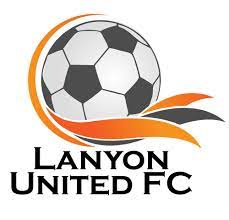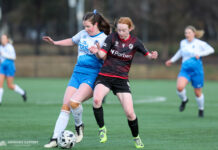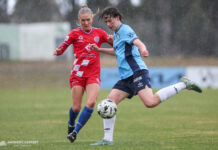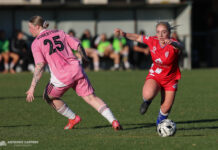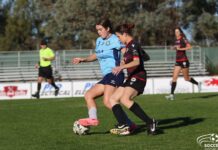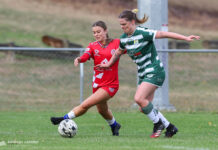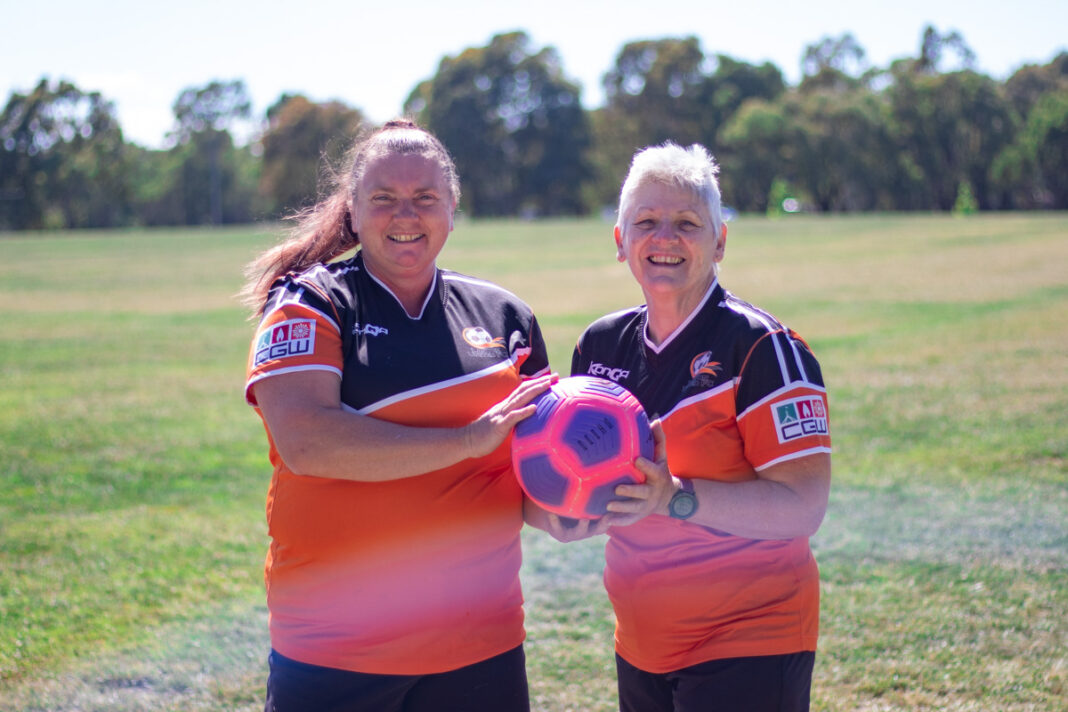
Lanyon United FC are based in South Tuggeranong, playing in the ACT’s state and community leagues. Starting out with just two men’s teams, the club is entering its 21st year of existence with plans to field two women’s and five men’s sides. In its heyday, eleven teams were playing under the Lanyon banner, with half of them women’s teams.
Long time player and current women’s team coach Johnny Marchetti was featured in a Capital Football profile last year.
FACES OF FOOTBALL |
“If I had to paint a picture of Lanyon United FC it would look like one big family. We are small club with a big heart.”
Johnny Marchetti’s been volunteering since 2008 & has loved every minute.
Read more about his story, here: https://t.co/Yeve1ynemA pic.twitter.com/ZEPB9Z2FXU
— CapitalFootball (@CapitalFootball) August 23, 2021
Founding club member Steffen Moebus spoke to two Lanyon United women’s legends, Liz Pitt and Colleen Harvey, about their significant role and history with the club, and what enjoyment of the beautiful game looks like for them.
When did you join Lanyon United and what was your football history prior to joining the club?
Colleen: “I think I joined 2002/2003. Before that, the only thing I played was summer 6’s. My first game of soccer was when I was 37 after I made a smart-arse remark after my daughter Caitlin had her first season – she was 5. They were handing out pamphlets for Summer 6’s and I made comments to the mothers, ‘We should play that and get the kids to come along and watch us,’ and everyone went, ‘Yeah!’. I got addicted to it very quickly and came over to Lanyon maybe two years later. I was out two seasons with injury and have been playing ever since. I hope to be playing this year!”
Liz: “I arrived in Australia [from New Zealand] around 2001. It was my very first year playing soccer, purely to make friends and get to know people. Like Colleen, I became addicted to it, found I had some good skills and a decent kick on me. Prior to that, I watched soccer on TV but couldn’t work it out. I’ve played ever since, I don’t think I’ve ever had a season off. I played through injury – broken wrists, cracked ribs, hamstrings – and I still managed to complete half a season [each time]. Hopefully I play out this season and keep going if my body will allow me … I think I started with Lanyon 2003-2004.”
Liz is the only remaining active player from the first Lanyon women’s teams. There were two women’s teams that season and a third was added a year later. By the time the club grew to have five women’s teams, several of them were in a golden era.
L: “At that time the women were really dominant and had around three teams in grand finals.”
C: “I coached a State League 5 team to the finals one year and we won the final, and our Masters team was often in the finals. We won it one year and were runners up several years to Weston Creek.
“We were a good cohesive team and we supported each other a lot – still do. That’s one of the great things about Lanyon and I hope it continues like that: we accept everyone no matter what their level. And we’re pretty good at not tolerating rubbish from people … ”
L: “One of our players has MS [multiple sclerosis]… she felt really bad as she could only do 10 minutes at a time, and now she’s playing almost full games and she’s into futsal. She’s got some skill.
“I went into the Capital Football offices for our ten year anniversary and checked the records. I have to say, there were more [Lanyon] women’s teams than men’s in the record books at that time.”
C: “We’re quite competitive considering we’re very much a social club. And I think that’s what actually brings a lot of women and keeps a lot of women at Lanyon in comparison to some of the other clubs. On the whole, I find at Lanyon, when you make a mistake, the rest of your team aren’t on your back, you’re more upset at yourself than the team are. Everyone goes, ‘Try again’ here … I have seen the abuse of players from their own teammates on the field so often, and I’ve seen so many young, talented people walk away from the game because of that, but I have not seen any significant amount of that at Lanyon.”
What else keeps you both coming back to the club?
C: “The idea of playing to the best of your ability, playing together as a team, and enjoying yourself.”
L: “I come back every year for the community and social aspects too. There’s no real nastiness. Most of that was weeded out in the very early years … the last few years for me, it’s really been about the girls’ team. We have lots of fun and laughs, and some social things outside of the club. And the other part for me is club loyalty because I’ve put so much into it. I’ve put 14 years on the Board, and I don’t really want to see it go down the drain.
“I either play for Lanyon or I don’t play for anyone. My loyalty is very strong for the club.”
C: “This is my outlet. When the kids first started my weekends were taken up with football because I had three kids playing juniors and then some of them went to seniors. But my game time was my time for me. It’s the same now.
“I was going to retire at 50 but I’m still coming back this year. I’ll play 10 minutes here, five minutes there, if that helps the team. If they need me out there for the whole 90 minutes I’ll be out there for them. I’m happy to give what the team needs, even if it’s running the line, as long as I can give something to the girls and to the club.
“Lanyon is about getting out there, having a go, and building that confidence. ‘Look, I put the ball to that person, and they scored’ – that sort of confidence extends to the rest of their lives.
“I’ve seen it with some of the young kids, both girls and guys. You can see, they really don’t have a lot of positives in their life, and if we can bring them down here and give them some positives, it gives them more courage to go forward and try other things as well.”
L: “I think the other thing too, with Lanyon, that’s different from some of the other clubs, is the support from both men and women. When the men play – even the away games – you often get women players [supporting]. Then the following day, you’ve got some of the guys at the girls’ games. It’s not the whole club, but it makes a difference having that support. I know for me personally, if I’ve got club members at games I play differently – I want to show them what I’ve got, and tend to play better.”
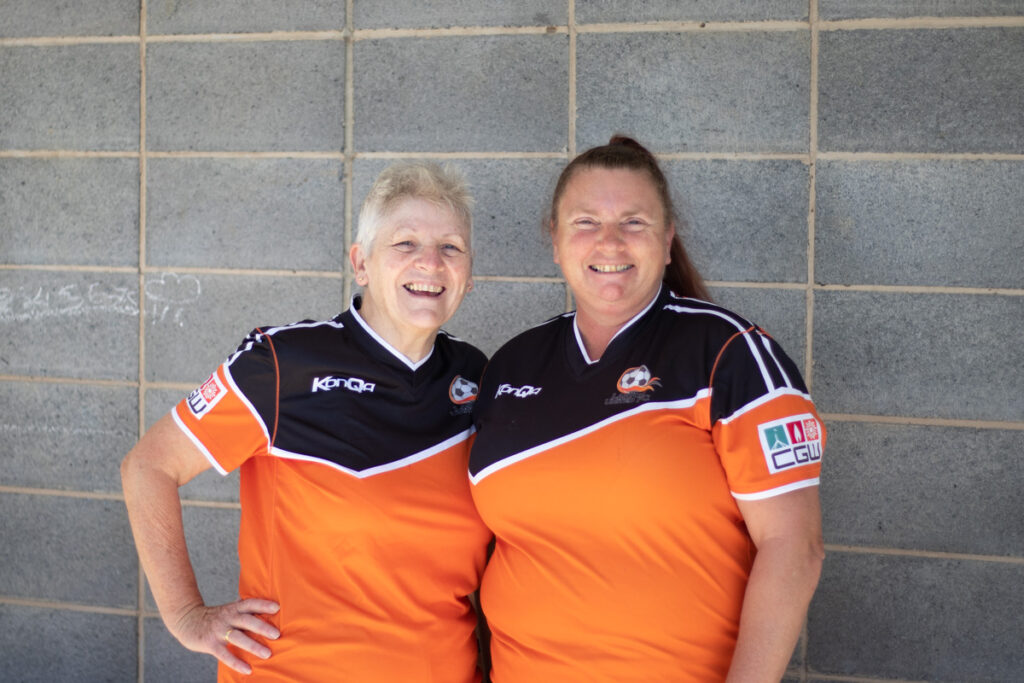
It’s interesting that with both the men’s and women’s teams we’ve had a period of time where teams were more successful and competitive but have now come back more to community/social football …
C: “We’ve only got two [women’s] teams now as opposed to the five or six we had. If you have a look across Canberra and the growth in other sports … women are trying different sports. My youngest daughter played with us for a couple of years, but her friends were doing AFL and encouraged her to have a go. But it’s interesting to talk to her. It’s not so much the game of AFL. It was the group of girls that she became friends with … she said it’s not that she enjoyed playing AFL more than playing football, it’s the friends she made.
“They’re mixing with people from different backgrounds and different stages in their life.”
Liz adds:
“Our team ranges from [my daughter] Ashleigh – the youngest at 20 – to the oldest being me. So we’ve got a range of 40 years. And we’re all cohesive.”
As we will see, this was not the only point in the discussion where the importance of bonding with others and personal connection is revealed to be integral to many women’s football life experiences.
You both had significant roles on the Board.
L: “14 years on the board. Three years as president. In those three years, I was also the official photographer/videographer. I was at almost every single game taking photos.
“I had a few years as women’s delegate at the beginning. I was treasurer and registrar at the same time. The only role that I haven’t done is secretary. I was public officer for a while but apparently, that was illegal because I lived in New South Wales [laughs]. Colleen only picked up a few years ago that it had to be an ACT resident.”
C: “I’ve been women’s delegate, registrar, and canteen manager.”
L: “That first year I was president … there was some shock, I think even with Capital football. I was the only female president that first year, maybe even the whole time. But I stood my ground with them. Through that three years, there was a fair bit of respect from a lot of the male players. I think the first year was like, ‘Who are you ?’ but after that, there was an acknowledgement that this is our president and this is what she’s doing for us. That respect took a while because it was new.”
All three of us know from experience how satisfying it is to have our kids joining the club and playing with us, and the shared bond that creates. [Liz’s daughter Ashleigh has been with the club a long time, as has Colleen’s daughter Caitlin. Colleen’s other daughter Nicki and son James also spent two seasons with the club.]
L: “Yeah, it’s an outlet that you share, but also extra fights in the car [laughs]. ‘Mum, what were you thinking?’ I know with Ashleigh when I’m in goals and she was sweeper, we had a great connection in the defensive line. And it certainly strengthened our bond quite a bit.”
C: “Caitlin has been with the club more than ten years and is very much an integral part of Lanyon. Marrying the ex-President probably helps [laughs]. She’s made some good friends here. It’s great that [team-mate] Lauren [Napper-Ferrari, who did outstanding work as a sign language interpreter in many ACT Government press conferences during the Covid pandemic] is going to officiate her wedding – Lauren is actually a marriage celebrant.
“It’s a good thing for the club to see family connections – and partners – coming along. It’s like a nice role model for the club. They can see that we’re all in there, enjoying our time there, so it must be a pretty reasonable place to be.”
The impact that the club has on the player community is especially strengthened in times of need. The 2021 Club Person of the Year was awarded after a player reached out to another player in a low ebb, providing vital support at just the right moment during Covid lockdowns. There have also been club-wide fundraising events for a player injured in a car accident while travelling to another state, and for the large family of a player who suffered a heart attack near Christmas time a few years ago.
The club pulling together in times of need can be a powerful, positive force in the lives of its members.
It must be satisfying for you both to see Sarah [Marchetti] and Rochelle [Fischetti] stepping up as president and vice-president this year, in some ways following in your footsteps.
L: “Yeah, I think it’d be great for Sarah and Rocky, because we’ve been through a female president before. And I think the boys or the players are fairly respectful of the position they hold, and what they will bring to the club.”
It’s also nice for them to know they’ve got you both as experienced sounding boards if they need it.
C: “You bring quite a bit having strong women on the Board. Neither of us was reticent coming forward if we thought we saw something. I remember arguments on several occasions where it was, you know, we want to buy a new shirt. Or if we buy it for the top men’s team, then the women can have our old ones. Soccer balls as well. I remember being here sorting out equipment, and they’re going, ‘There’s the bag for the top men’s. And, oh, that’s the women’s’. No, you’re not doing that, we are not having the broken bag. We’re not coming last again, we’ve been the most successful team. And I dug my heels in, and then they actually went out and bought us a new one.
“We got past that … to now being a really integral part of the club. And I know some players have come to our club because of the way they were treated elsewhere, even though they were the people that were building their club.”
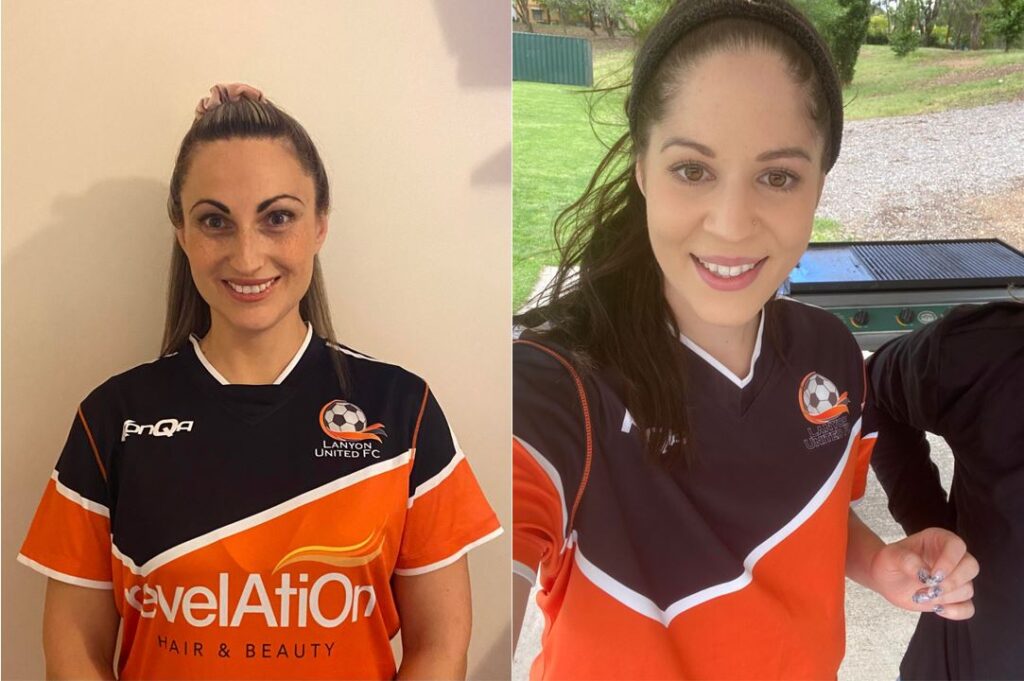
Where do you see the Canberra women’s football landscape and Lanyon’s place in it?
C: “Just because of the nature of age groups and women, you’ll get the young girls really interested. Then they get to their late teens and boyfriends, pregnancy, all that will take over, trying to juggle everything. I think we are seeing pathways, but my big thing is … there are both women and men who want to play for fun. And we had to create this atmosphere where it’s alright to have fun. It’s alright to get out there and do your best, even if you aren’t great. There’s a place for you. I think that’s where Lanyon should aim to fit themselves.”
L: “Women’s soccer is growing, but it’s slow. I don’t think it grows as quickly as men’s, purely just because of home life responsibility. We end up having a couple of years off, and then it’s a slow return coming back into it. Sometimes a core bunch of a team is at that age where they’ve gotten married and are having kids all at the same time. Football is something you may come back to later, and that’s where we need to keep those bonds at the club.”
How much do you draw inspiration from – or are aware of – the senior levels of football in town, the NPLW level? Do you watch the streamed NPLW coverage? How much do you follow Canberra United and the Matildas?
C: “I follow the Matildas. Canberra United, I haven’t gone the last two years, but I have been to a number of games in the past. Premier League – not really; only back when my kids were playing it …”
L: “I don’t follow the Matildas. I don’t follow Canberra United and I don’t follow the NPLW. What I find is when I’ve watched some games … the top women’s [teams] are getting better, but they don’t quite have that flair so it doesn’t catch my attention.
“I’ll watch [men’s] English Premier League if there’s a good game, [I enjoy the] edge of your seat stuff.”
C: “I have a different way of looking at it to a certain extent in that their style of game – because of their power and their speed – is very different. And if you go and watch it [for example NPLW or A-League Women’s] at ground level, you realise how much better they are than we are – you can appreciate the skill, but you really have to have a different mindset watching it.”
What I’m hearing is that it’s more important for you to have that connection with your own club, with your own family and the team.
L: “World Cups and the like – men’s and women’s – I’ll watch it. But yes in general, for me, I get more enjoyment out of watching community, grassroots football. You’re on the side of the field. And you see it. You can see the team, you can see their faces, you can see just how much effort they’re putting in.”
Colleen adds:
“I think with women as a whole, we do tend to look for connections.”
It was refreshing to gain some insights from the perspective of local community football stalwarts in this discussion. It highlighted that club culture and a personal connection with others makes or breaks their experiences and keeps them coming back year after year, family circumstances permitting.
What is also apparent is that it’s not enough just to have higher level football products in existence.
To make elite football products appeal to fans, clubs and league administrators have to forge that sense of personal connection and belonging with their product.
Without that, potential fans will continue to gravitate towards what is near, dear and local to them in a football sense.
The trick lies is in working out how to make your elite football product near and dear to the grassroots football heartland. That doesn’t necessarily mean investment; the will for that to occur is arguably just as – or even more – important. That will needs to be there at all levels. Grassroots players will often draw inspiration from their local playing heroes within their club or their greater community if exposed to their stories and experiences, and this can naturally lead to an interest in football at those higher levels.



